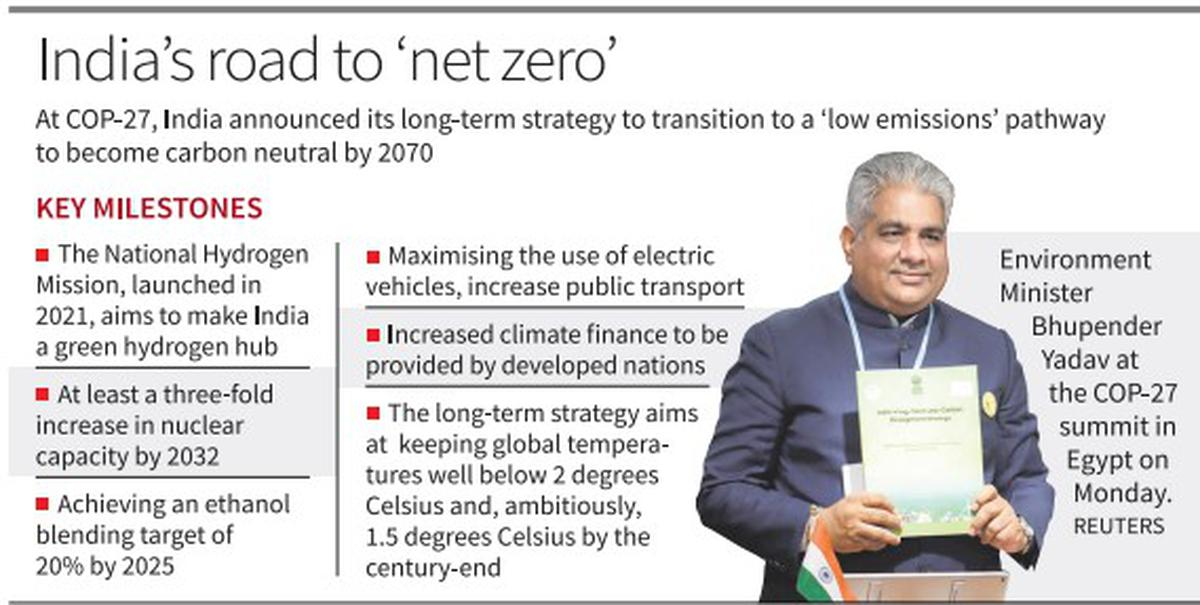India’s Net Zero Strategy | 16 Nov 2022
For Prelims: Paris Agreement, United Nations Conference on Climate Change (COP 27), Nationally Determined Contributions (NDC), Net zero, ethanol blending, Hydrogen fuel, Perform, Achieve and Trade (PAT) scheme, National Hydrogen Mission, Biofuel
For Mains: Paris Climate Agreement and its Impacts.
Why in News?
Recently, India submitted its Long-Term Low Emission Development Strategy to the United Nations Framework Convention on Climate Change (UNFCCC) at ongoing 27th Conference of Parties (COP27) in Sharm el-Sheikh, Egypt.
What is a Long-Term Low Emissions Development Strategy?
- The LT-LEDS are qualitative in nature and are a requirement emanating from the 2015 Paris Agreement.
- Under the Paris agreement, countries must explain how they will transition their economies beyond achieving near-term Nationally Determined Contributions (NDCs) targets and work towards the larger climate objective of cutting emissions by 45% by 2030 and achieve net zero around 2050.
- The Strategy is based on four key considerations that underpin India’s long-term low-carbon development strategy.
- India has contributed little to global warming, its historical contribution to cumulative global GreenHouse Gases emissions being minuscule despite having a share of ~17% of the world’s population
- India has significant energy needs for development
- India is committed to pursuing low-carbon strategies for development and is actively pursuing them, as per national circumstances
- India needs to build climate resilience
- The LT-LEDS is also informed by the vision of LiFE, Lifestyle for the Environment.
- LiFE calls for a world-wide paradigm shift from mindless and destructive consumption to mindful and deliberate utilization.
What are the Features of the LT-LEDS?
- The strategy will focus on rational utilization of national resources with due regard to energy security.
- The transitions from fossil fuels will be undertaken in a just, smooth, sustainable and all-inclusive manner.
- The strategy will promote increased use of biofuels, especially ethanol blending in petrol, the drive to increase electric vehicle penetration, and the increased use of green hydrogen fuel are expected to drive the low carbon development of the transport sector.
- India aspires to maximize the use of electric vehicles, ethanol blending to reach 20% by 2025, and a strong modal shift to public transport for passenger and freight.
- Low-base, future sustainable, and climate-resilient urban development will be driven by smart city initiatives, integrated planning of cities for mainstreaming adaptation and enhancing energy and resource efficiency, effective green building codes and rapid developments in innovative solid and liquid waste management.
- The industrial sector will continue in the perspective of ‘Aatmanirbhar Bharat’ and ‘Make in India’.
- India will also focus on improving energy efficiency by the Perform, Achieve and Trade (PAT) scheme, the National Hydrogen Mission, increasing electrification, enhancing material efficiency, and recycling and ways to reduce emissions.
What is Net Zero Target?
- It is referred to as carbon neutrality, which does not mean that a country would bring down its emissions to zero.
- Rather, it is a state in which a country’s emissions are compensated by the absorption and removal of greenhouse gases from the atmosphere.
- Further, absorption of the emissions can be increased by creating more carbon sinks such as forests.
- While the removal of gases from the atmosphere requires futuristic technologies such as carbon capture and storage.
- Further, absorption of the emissions can be increased by creating more carbon sinks such as forests.
- More than 70 countries have promised to become Net Zero by the middle of the century i.e., by 2050.
- India has promised to cut its emissions to net zero by 2070 at the conference of parties-26(COP) summit.
UPSC Civil Services Examination Previous Year Question (PYQ)
Prelims
Q. The term ‘Intended Nationally Determined Contributions’ is sometimes seen in the news in the context of (2016)
(a) pledges made by the European countries to rehabilitate refugees from the war-affected Middle East
(b) plan of action outlined by the countries of the world to combat climate change
(c) capital contributed by the member countries in the establishment of the Asian Infrastructure Investment Bank
(d) plan of action outlined by the countries of the world regarding Sustainable Development Goals
Ans: (b)
Exp:
- Intended Nationally Determined Contributions is the term used under the UNFCCC for reductions in greenhouse gas emissions in all countries that signed the Paris Agreement.
- At COP 21 countries across the globe publicly outlined the actions they intended to take under the international agreement. The contributions are in the direction to achieve the long-term goal of the Paris Agreement; “to hold the increase in global average temperature to well below 2°C to pursue efforts to limit the increase to 1.5°C, and to achieve net zero emissions in the second half of this century.” Therefore, option (b) is the correct answer.
Mains
Q. Describe the major outcomes of the 26th session of the Conference of the Parties (COP) to the United Nations Framework Convention on Climate Change (UNFCCC). What are the commitments made by India in this conference? (2021)

